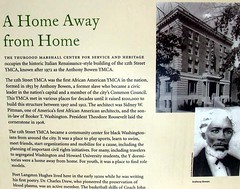More about DC Tourism Marketing
(think of this as a continuation of the entry from yesterday)
4. Another thing I keep meaning to write about is the recent production of a cultural heritage tourism map of the Appalachian Region, which appeared in the April issue of National Geographic Traveler Magazine (note to local cultural heritage advocates, publications like these are important and are must reads for getting good ideas and seeing best practices.) One of many articles about this project is "Promoting Appalachia: Commission encourages tourism in 13-state region," an AP article from today's online Pittsburgh Post-Gazette. (There was a conference in April in Asheville, co-sponsored by the Appalachian Regional Commission and the Handmade in America National Heritage Area about this and "Building Creative Economies" that I wanted to go to but just couldn't swing it. Handmade has done some interesting work in mapping the Creative Economy in Asheville and other communities.)
From the article:
The commission has partnered with the National Geographic Society to develop a "geotourism" map promoting an eclectic mix of more than 350 attractions reflecting the diversity of the 13-state region. Attractions include both the mainstream and the obscure, from the National Baseball Hall of Fame and Museum in Cooperstown, N.Y., to what's billed as the oldest continuous flea market in Ripley, Miss. Also featured are Civil War sites, museums, parks, hiking trails, festivals, historic districts, spas and resorts, celebrity birthplaces, prehistoric Indian mounds and notable farms.
"This map delivers a taste of Appalachia's distinctive culture and heritage to a wide audience, exposing this 'undiscovered national treasure' to many first-time visitors," the ARC said in a news release. Anne Pope, co-chairwoman of the ARC, said the goal is to spur economic growth by drawing tourist dollars to the area. "ARC recognizes the economic potential of tourism for the region," she said. "This type of tourism encourages the preservation of a site's unique sense of place and strengthens its prospects for long term sustainability."
_______
Also see "ARC–National Geographic Geotourism Project Geotourism Map Guide to Appalachia," which links to the online version of the map. I will say that like a lot of NGS maps, it's probably somewhat difficult to use from a trip planning perspective (which has five stages: dream; plan; book; go; come back -- from an article about Lonely Planet Travel Guides in an April issue of New Yorker Magazine).
I think we need to do something similar for DC's local history. I would make a map with one side focusing on the local cultural heritage experience and the other on the National-Federal architectural and history experience that for 99.9999999% of people in the world, defines Washington, DC.
 A portion of one of the signs on the DC African-American History Trail.
A portion of one of the signs on the DC African-American History Trail.5. Last week, the Richmond Times-Dispatch introduced a new feature on Friday, a two-page "pull-out" of things to do on the weekend. It's easy to fold up and take with you. It's called Weekend Update, and while they have it online as a text file, it really works best in print. (For those of you with burning interest, pick up a copy next Friday.)
Similarly, I think that we need to do something similar for the local cutural experience. The long emails from the various groups with a myriad of things to do, not super-well organized, are overwhelming and increasingly un-useful--I pretty much delete them now without looking at them.
We could still do those kinds of emails (but better organized), but how about a link to a 2-page or 4-page printable Adobe Acrobat file of the week's Cultural activities? (which is something that the Richmond Times-Dispatch should do as well)



0 Comments:
Post a Comment
<< Home